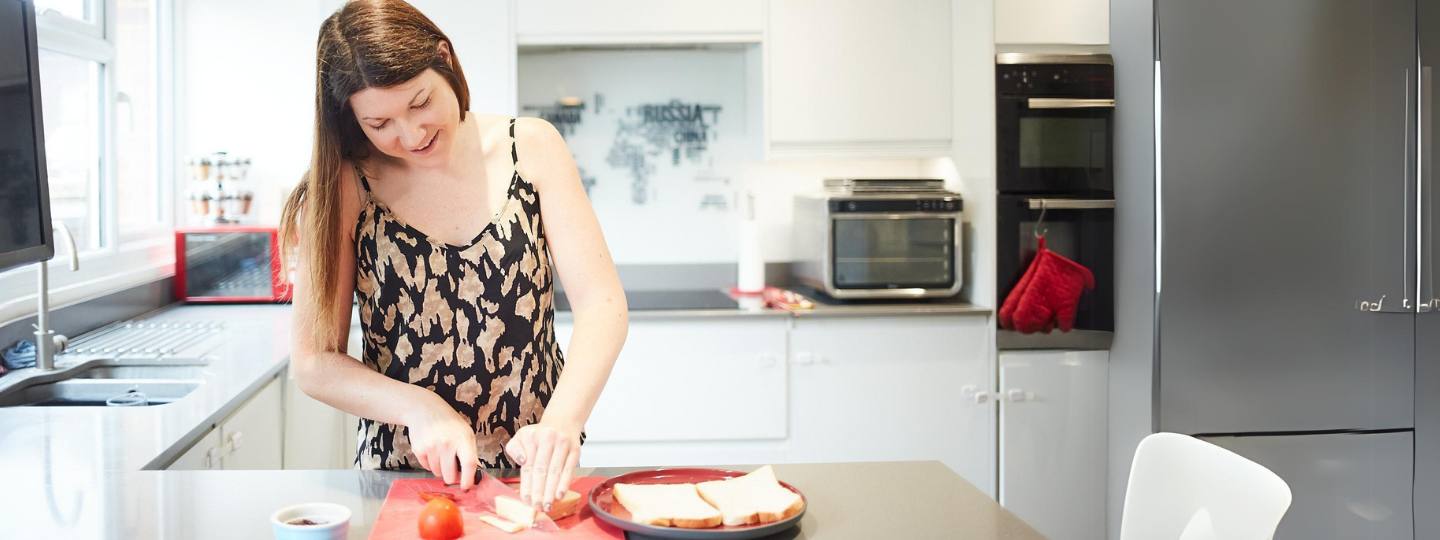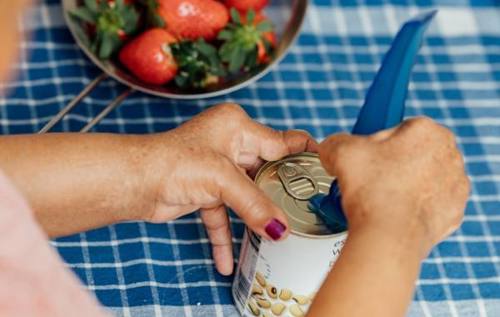Cooking with arthritis: Tips for making meals easier and more enjoyable
14 March 2024
Cooking a wholesome meal can be a great way to look after ourselves, unwind after a long day, or show a loved one we care.
But we know that for some people living with arthritis, the thought of preparing meals can be a little daunting.
Chopping, stirring, or even holding utensils can be challenging if you have stiff and painful joints. But with a few adjustments, it's possible to make your kitchen work better for you.
Sign up to our newsletter for more tips and advice
Tips for cooking with arthritis
Here people living with arthritis share their tips on making cooking more enjoyable and manageable.
Batch cooking
If you want to save a bit of time and money, batch-cooking is a good place to start.
Batch cooking, or cooking in bulk, simply means cooking more than you need, so you can store and eat it later. And it can be a helpful strategy for days when you have a bit more energy.
“The most important thing I do is batch cool. On a Sunday, I'll make four lunches for the whole week. Then for the rest of the week, I don't have to worry about having to cook something from scratch every day.”
Use your freezer
To prevent food waste and make your groceries stretch further, you could try freezing meals too.
“If I’m making dinner, I’ll make portions for the next 2-3 days and I’ll freeze a load. Then I’ve got a portion that I can defrost whenever I need it,” says Emily, 30, who lives with inflammatory arthritis.
Use aids and adaptations
 If you’re struggling to cook, it might be worth seeing if there are any gadgets or equipment that could help make things a little easier. These are sometimes called aids and adaptations.
If you’re struggling to cook, it might be worth seeing if there are any gadgets or equipment that could help make things a little easier. These are sometimes called aids and adaptations.
For example, maybe it'd be easier to enjoy your meal if you used adaptive cutlery. These are knives, forks, or spoons that are specially designed to make them easier to use. So, they might have thicker, softer grips, for example.
Aids are equipment that help you manage everyday tasks, such as cooking. They include items such as:
- Two-handed saucepans.
- Kettle tippers.
- Cutlery with large handles.
- Electric tin openers.
- Nonslip kitchen cutters.
Adaptations are changes or additions to your home. For example, adding lever taps to your kitchen sink.
Most lever taps only need a quarter turn to turn the tap on and off. So, they can be helpful if you have poor grip.
Aids and adaptations can be expensive. But you may be eligible to get aids and minor adaptations worth less than £1,000 for free from your local council. This is sometimes called ‘community equipment.’
To check if you’re eligible, simply ask your council for a free needs assessment.
Buy pre-chopped or prepared food
Fruit and vegetables are a mainstay of any healthy, balanced diet. But we know that chopping, slicing, and cutting food can be tough if you have sore hands or poor grip.
If this is something you find challenging, why not make things easier for yourself and opt for pre-chopped or prepared foods?
You can find many of these in the frozen aisle of your supermarket and they’re often cheaper. Best of all, frozen fruit and vegetables can have just as many (or sometimes more) nutrients as fresh!
You could also try using microwavable rice pouches, prepared salads, or other pre-made meals. Don’t be afraid of the odd processed or pre-packaged food too. It’s about finding what works for you.
Lighter pots and pans
Holding heavy items like pans, saucepans, or kettles can be tough when you have sore, achy arms. So, it might be worth swapping to lightweight alternatives if you can.
Christine, 75, who lives with osteoarthritis says: “I’ve ditched my heavy kettle because of my wrist. I’m never sure if my wrist is going to give out.”
Pace yourself
 Pacing yourself is all about listening to your body and taking breaks if you need them.
Pacing yourself is all about listening to your body and taking breaks if you need them.
By reducing discomfort and fatigue, it might allow you to enjoy the cooking process without overexerting yourself.
“Do it at your own pace,” says Emily, 30, who lives with inflammatory arthritis. “Let’s say I’m making a butternut squash salad that has quite a few steps. I’ll peel and chop the vegetables in the morning and in the evening, I’ll roast them.”
If you find it difficult to stand for long stretches, don’t hesitate to sit down too.
75-year-old Christine has osteoarthritis in her hip, knee, neck, lower spine, hands and wrists.
She says: “I spend a lot of time alone, and arthritis can be very limiting. I like cooking, but standing in the kitchen for any length of time is very difficult. I have to do something and sit down for a bit and repeat.”
Simple recipes
Mealtimes don’t have to be complicated. Why not choose recipes that need minimal chopping, stirring, or other tiresome techniques?
One-pot meals, sheet pan dinners, and slow cooker meals can be fantastic ways to simplify mealtimes. So, it’s worth knowing a few recipes offhand.
Don’t overlook your microwave too. There are many foods that you can quickly prepare in the microwave, rather than on the hob. For example, you could quickly microwave your veggies to help save a bit of time and energy.
Need some recipe inspiration? Our quarterly magazine, Inspire, is packed with tasty recipes to help you get started. It’s also full of features, news, tips and information on how to live well with arthritis and related conditions.
Get Inspire Magazine delivered to your doorReorganise your kitchen
Stretching for hard-to-reach cupboards can be challenging. So, make sure common items are handy and accessible.
If you’re moving home, it’s also worth considering the layout of your kitchen.
Jack, 36, lives with psoriatic arthritis and says in his last kitchen, “the cupboards were really high up.”
“I’m not short but I would have to use a step ladder to access the very top ones, which — if your arthritis leaves you a bit wobbly — isn’t very good.”
That’s why he was thankful when he saw that the cupboards in his new home were much lower.
Make grocery shopping easier
Find grocery shopping exhausting? Nowadays, most supermarkets offer online shopping. So, you can get your groceries delivered to your home at the click of a button.
Ask for help

Remember you don’t have to do everything on your own. Maybe a friend or family member could help cook dinner or do the grocery shopping?
Cooking can be a joyful experience, and having an extra set of hands might make it a bit easier for you. Plus, it’s a fantastic way to spend quality time with loved ones.
Join our online community for more tips and adviceWe’re here for you
If you need more advice or support, remember you can:
- Call our free helpline on 0800 5200 520
- Chat to our Arthritis Virtual Assistant
- Join our online community.
- Stay in touch and follow us on X (Twitter), Facebook and Instagram.